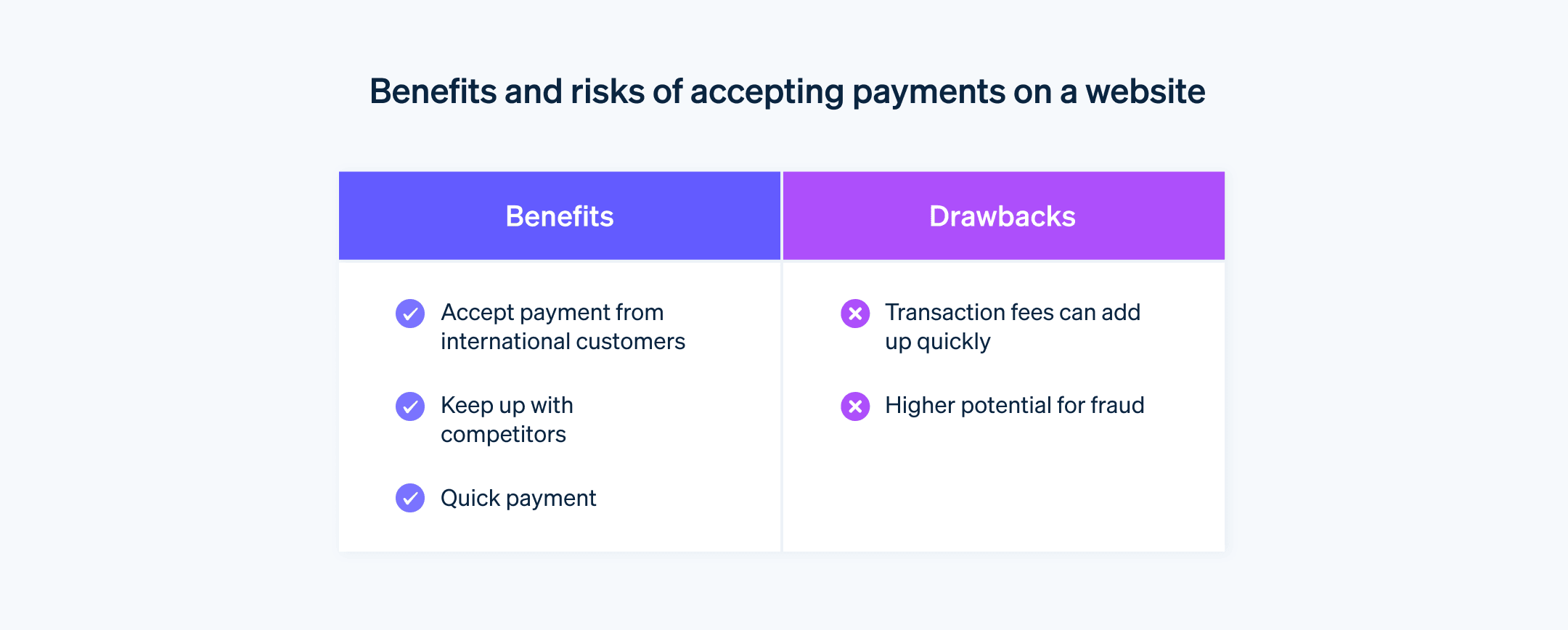互联网的便利性、速度和覆盖范围促使各种企业将线上付款系统整合到他们的网站中。随着当今许多支付处理选项的普及,在您的企业网站上接受付款变得空前简单。
线上接受和处理付款可以扩大企业的潜在客户群,简化运营,并反映客户对数字支付选项的偏好。企业感到压力很大,需要在其网站上提供简单、安全的交易体验,以保持竞争力。
如何实施线上付款取决于每个企业的许多因素,包括其销售的产品以及其目标客户群和市场。在您的网站上接受付款之前,您应该了解您的特定业务需求。下面概述了线上付款的运作方式、需要考虑的风险和收益以及如何开始。
目录
- 您可以在网站上接受信用卡付款吗?
- 哪些类型的企业需要在网站上接受付款?
- 在网站上接受付款需要多少费用?
- 在网站上接受付款的好处和风险
- 如何在网站上接受客户的付款
您可以在网站上接受信用卡付款吗?
是的,在网站上接受信用卡付款 是可行的。企业可以通过集成一个安全的支付处理系统来处理客户交易。Stripe 等现代支付服务商使网站可以轻松处理这些付款,确保支付过程对双方都安全、高效。
哪些类型的商家需要在网站上接受付款?
过去,只有某些企业(例如电商零售商和软件即服务 (SaaS) 企业)需要通过网站接受线上付款。但是,随着数字支付技术的进步以及功能和用例的多样化,更多类型的企业开始接受线上付款。
以下类型的企业可能需要在其网站上接受付款:
- 销售实物商品(如服装或电子产品)的电商零售商需要能够接受线上付款。电商 付款是即时的,可以跨境。
- 提供数字产品或服务(如软件、音乐、电子书或在线课程)的企业在网上蓬勃发展,在这些企业中,支付处理是客户旅程的重要组成部分。
- 订阅服务 — 无论是流媒体内容、在线杂志还是会员网站,都严重依赖自动经常性付款,这是线上付款系统启用的一项功能。
- 非营利组织线上接受捐款,提高了筹款工作的便捷性和覆盖面。
- 旅游和酒店业(例如酒店和航空公司)已将其预订系统转移到线上,从而简化了预订流程并提供更流畅的客户体验。
- 食品配送和在线杂货服务需要线上付款系统来快速安全地完成交易,确保客户满意度。
- 音乐会、戏剧表演和体育赛事的活动组织者使用线上付款来简化门票销售,使与会者的流程更加方便。
- 专业服务提供商(例如顾问、自由职业者和教育工作者)接受预约和服务的线上付款。
- 房地产中介现在接受线上租赁和购物付款,减少了文书工作并加快了付款流程。
这些类型的企业对线上付款系统都有不同的要求。但是,他们都需要安全、高效、用户友好的方式来线上接受客户和捐助者的付款。
在网站上接受付款需要多少费用?
费用可能会因多种因素而有很大差异,包括您选择的支付处理服务、交易量以及您接受的支付类型。下面概述了通常与线上接受付款相关的基本费用:
支付手续费
大多数支付处理商都对每笔交易收取费用,通常是交易金额的一小部分加上固定费用。有关 Stripe 定价的详细信息,请访问此处。月费
一些支付处理商对使用其服务收取月费,尤其是对于高级功能,例如订阅计费、欺诈保护 以及其他增值服务。这些费用从每月几美元到每月几百美元不等。Stripe 不收取月费。设置费
虽然许多支付处理商不收取设置费,但有些会收取。如果您要为自己的企业设置商家账户,这种情况尤其常见。Stripe 不收取设置费。撤单费用
如果客户对收款提出异议并导致拒付,支付处理商可能会收取费用。每次拒付的费用可能为 15 至 25 美元或更多。Stripe 不对拒付收取单独的费用,尽管企业有责任支付有争议的交易金额和卡组织 的拒付费用。与某些卡类型相关的费用
某些类型的卡(如企业信用卡或奖励信用卡)可能会产生更高的手续费。
本文简要概述了您在为企业启用线上付款时可能遇到的典型费用,但并非详尽无遗。费率和费用可能因提供商而异,并且还因企业所属的行业、销售的产品、运营地点、销售量和常见的支付方式而异。在选择支付处理服务之前,请仔细查看定价详细信息和服务条款。
在网站上接受付款的好处和风险
在网站上接受付款使客户的交易变得容易,并扩大了企业的市场覆盖范围。但接受线上付款既有好处也有风险:

优点
增加便利性
提供线上付款使客户能够在任何可以访问互联网的地方进行购买。这包括移动交易,许多客户更喜欢在智能手机上购物。这种全天候可用性可以显著提高销售额并满足客户期望。扩大覆盖范围
通过接受线上付款,企业可以向世界各地的客户销售他们的产品和服务。这种覆盖范围消除了实体店的地理限制。更高效的运营
通常,线上付款系统配备了用于跟踪销售、管理发票和监控客户数据的工具。这些功能使企业能够自动执行大量管理任务,从而减少手动工作量并提高运营效率。改善现金流
线上交易几乎是即时处理的,这可以改善企业的现金流并实现更敏捷的财务管理。
风险
欺诈和安全问题
线上交易容易受到网络威胁,包括欺诈活动和数据泄露。企业必须投资于强大的安全协议和加密 技术来保护敏感的客户信息并维护信任。实现这一目标的方法之一是选择能提供这些功能和服务的支付服务商。点击此处 详细了解 Stripe 用于保护支付 以及检测、预防和应对欺诈 的内置综合措施。拒付
拒付(客户对交易提出异议并要求退还资金)可能代价高昂。它们会导致收入损失并产生费用。频繁的拒付会损害企业的声誉,并可能导致支付处理商加大审查力度,甚至可能收取更高的费用。技术问题
网站崩溃或技术故障可能导致销售损失和客户沮丧,并对企业声誉造成持久损害。定期维护和及时排除故障对于确保流畅的用户体验很有必要,这对于保持现有客户忠诚度和为潜在的新客户创造积极的口碑非常重要。法规遵从性
所有企业都必须遵守法律法规,例如支付卡行业数据安全标准 (PCI DSS)。驾驭这些要求可能既复杂又耗时,但不合规可能会导致巨额罚款和企业声誉受损。
在实施线上付款系统时,了解这些好处和风险。经过深思熟虑的策略有助于您实现收益最大化、减少潜在的挑战,从一开始就建立高效的运营。
如何在网站上接受客户的付款
在网站上接受付款是一个多方面的过程,包括选择正确的工具并将它们整合到您的网站中。有多种解决方案可用,每种解决方案都满足不同的业务需求和用例,并且每个解决方案都有不同的设置过程。但在大多数情况下,设置和部署网站支付所涉及的整体步骤看起来相似。概述如下:
1. 确定您的业务需求
第一步是了解您企业的具体要求。您是否需要处理一次性付款、经常性订阅还是兼而有之?您的企业是否在多个国家/地区运营,并且需要支持不同货币 和支付方式?您是否需要能够在多个收款人之间拆分付款?您的回答将告知适合您的支付解决方案类型。
2. 选择支付处理商
确定您的需求后,选择一家能提供对您来说重要的功能的支付处理商,最好能与您现有的操作系统集成,最大限度地减少障碍。请考虑交易费用、安全措施、支持的支付方式和客户支持等因素。
3. 在支付处理商处创建一个账户
创建账户通常涉及填写一份包含企业信息的表单,还可能需要通过验证流程。要开始使用新的 Stripe 账户,请转到此处。
4. 将支付处理商整合到网站中
根据您的网站和您选择的支付处理提供商的不同,这一步会有些不同。大多数支付处理商都提供预构建的插件或 API 用于集成。如果您使用的是 Shopify、WooCommerce 或 Magento 等流行的电商平台,它可能会提供现成的集成。如果您要构建自定义网站,则可能需要聘请开发人员来集成支付 API。如果您正在寻找一家能满足各种业务规模和使用情况的支付处理提供商,Stripe 有一个对开发人员友好的 API 库,以及低代码和预建解决方案。
5. 配置您的付款设置
选择您要接受的货币和支付选项。在这个阶段,一些企业可能还希望设置订阅模式、经常性付款和先买后付 (BNPL) 选项。
6. 测试您的支付系统
使用支付处理商的测试模式来模拟交易,并确保一切正常。这有助于在客户遇到任何问题之前识别和修复任何问题。
7. 启动您的支付系统
彻底测试您的支付系统后,您可以将其切换到真实模式并开始接受付款。
8. 管理您的交易
定期监控您的交易,处理任何争议或拒付,并跟踪您的销售业绩。大多数支付处理商都提供仪表板或分析工具来协助解决这个问题。
9. 遵守合规和会计要求
确保您遵守所有必要的法规和标准,例如 PCI DSS,它规定了企业应如何处理信用卡数据。如果您提供订阅或接受延迟或经常性付款,则还需要确保正确处理收入确认。
通过将支付系统系统性集成到您的网站中,您可以选择适合企业的模式,支持客户的首选支付方式,并提供直观、受保护、建立信任的交易体验。有关 Stripe 如何为企业线上付款提供支持的更多信息,请从这里 开始。
本文中的内容仅供一般信息和教育目的,不应被解释为法律或税务建议。Stripe 不保证或担保文章中信息的准确性、完整性、充分性或时效性。您应该寻求在您的司法管辖区获得执业许可的合格律师或会计师的建议,以就您的特定情况提供建议。